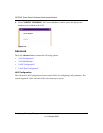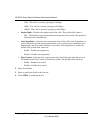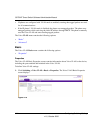
GS700AT Smart Switch Software Administration Manual
Configuring Switching Settings 4-14
v1.0, October 2008
VLAN
VLANs are logical subgroups with a Local Area Network (LAN) which combine user stations and
network devices into a single unit, regardless of the physical LAN segment to which they are
attached. VLANs allow network traffic to flow more efficiently within subgroups. VLANs use
software to reduce the amount of time it takes for network changes, additions, and moves to be
implemented.
VLANs have no minimum number of ports, and can be created per unit, per device, or through any
other logical connection combination, since they are software-based and not defined by physical
attributes.
VLANs function at Layer 2. Since VLANs isolate traffic within the LAN, a Layer 3 router
working at a protocol level is required to allow traffic flow between VLANs. Layer 3 routers
identify segments and coordinate with VLANs. VLANs are Broadcast and Multicast domains.
Broadcast and Multicast traffic is transmitted only in the VLAN in which the traffic is generated.
VLAN tagging provides a method of transferring VLAN information between VLAN groups.
VLAN tagging attaches a 4-byte tag to packet headers. The VLAN tag indicates to which VLAN
the packets belong. VLAN tags are attached to the VLAN by either the end station or the network
device. VLAN tags also contain VLAN network priority information.
The VLAN menu contains the following options:
• “Basic”
• “Advanced”
Basic
The VLAN Basic menu contains the following options:
• “VLAN Configuration”
VLAN Configuration
The Basic VLAN Configuration screen provides information and parameters for configuring and
working with VLANs. The maximum number of active VLANs is 128.


















